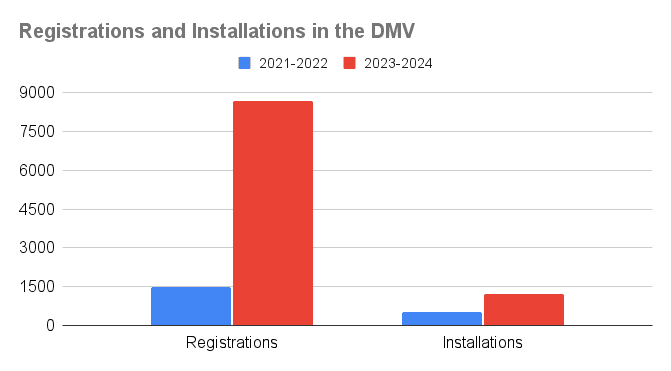
Solar United Neighbors (SUN), a Washington, DC-based nonprofit, recently rolled out a rebranded version of a group buying program that enables homeowners to purchase and install a solar energy system at up to a 25% discount. Homeowners are also able to claim a tax credit up to 30% of the cost on their federal income tax return.
The rebranded program is now called Switch Together and is run by iChoosr, which originated the program in Europe. SUN is iChoosr’s primary partner in the United States.
The two organizations came together following passage of the Inflation Reduction Act (IRA) in 2022. The IRA increased and extended the availability of the tax credit to 30% for any zero carbon energy system installed through 2032. Together with an economy rebounding from COVID, the new tax credit helped prime the market for greater interest in the switch to solar.
I participated in the program last year when it was called Solar Switch. The discount and tax credit brought the net cost of my installation in northern Virginia to $13,576. Without the discount and tax credit, the cost would have been $23,000 – $25,000 – an investment I was not prepared to make.
SUN also provides information on net metering, a state-based financial incentive for going solar.
With net metering available in most states, purchasers are also able to “sell” back to the power company any extra electricity they don’t use. This exported electricity earns credits that offset the cost of some or all power consumed at night and on cloudy days when the solar panels are not generating much or any power. For example, my electric bill for the billing period ended in March was $7.58 (my house is not heated with electricity); my bill for the same period over the last five years averaged $71.40. Of course, such savings may not be the story every month due to seasonal and weather differences. Even so, most installations pay for themselves within 8 to 12 years.
One other financial benefit: According to a 2019 Zillow study, installing solar panels can increase the value of a home up to 4%. More recent studies of solar’s impact on home sales also support the investment, with one study of 400 homes suggesting that in 2024, solar increased the sale price by an average of 6.8%.
The idea for SUN was inspired by two 12-year-old boys who, after watching the film “An Inconvenient Truth”, decided their parents needed to install solar panels on their homes. Anya Schoolman, the mother of one of the boys, explained to them the cost and complexities of their request. Rather than shut the idea down, though, she enlisted the boys to help engage 45 fellow homeowners in their Mt. Pleasant neighborhood of DC to form the Mt. Pleasant Solar Cooperative to make the purchase more affordable. A few years later, Schoolman founded and developed SUN into a national organization supporting the expansion of residential solar in 12 states plus DC and Puerto Rico. The organization currently offers three programs for going solar, including Switch Together.
iChoosr launched in the Netherlands and Belgium in 2009 with the objective of making the group buying experience more convenient and accessible for consumers who are new to the energy market. Their programs aim to save time and money both for consumers and installers. In its first six years, the company says over two million households investigated its programs, with 500,000 signing on and benefiting from them. Now, through the company’s Switch Together program, iChoosr provides an online platform that enables a homeowner to register, obtain an initial estimate, and get matched with an installer in about five minutes – all without obligation.
Partners like SUN manage the program in local communities, establishing relationships with local governments and businesses and coordinating program activities.
iChoosr and SUN first launched Switch Together in Texas and Colorado in 2022, then in the DMV (the District of Columbia and surrounding counties in Maryland and Virginia) in 2023. They next launched the program in Florida, Minnesota, and Ohio in 2024, with communities in Arizona, Nevada, Pennsylvania, and West Virginia set to participate this year. Through a separate partnership, iChoosr is also promoting the program in Illinois.
The partnership with iChoosr gave SUN the opportunity to scale their efforts in response to the expected demand. According to numbers reported by SUN for the DMV, the new program generated almost six times the interest in the two years after the program launched than in the two years prior. And it more than doubled the number of installations.
Nationally, Switch Together also generated a significant increase in registrations and a small bump in installations.
Despite the strong response and the program’s expansion to new states, the market outlook has grown murky. The fate of the tax credit under the Trump administration is unclear at this time as Trump attempts to cut and clawback funding for renewable energy projects.
Trump’s tariffs, and particularly his trade war with China, have thrown another curve at the market. According to a report from the International Energy Agency, as of 2022, China controlled 80% of the manufacturing needed to produce solar panels. The tariffs are likely to increase the cost of imported solar cells. While the increase will make it more expensive for American homeowners to go solar, it should benefit US solar manufacturers, making their products more price competitive.
The increased cost, however, should not affect SUN’s current spring campaign. According to Sukrit Mishra, partner director for SUN’s activities in the DMV, “installers’ supply chains and pricing are locked in, and the current market uncertainty shouldn’t impact our program offerings or ability to complete installs on schedule.”
Another ambiguity in the market has to do with net metering. Utilities in several states are questioning the continued viability of net metering for their business, arguing that as markets mature and become saturated with residential solar, net metering becomes a money-losing proposition for the utility. The North Carolina Clean Energy Technology Center reports that some states have already moved away from traditional net metering to “successor” programs that improve the revenue outlook for the utilities. For the most part, such programs reduce the immediate cost benefit and lengthen the payback period for homeowners who invest in solar.
For now, though, the tax credit remains available, near-term pricing should remain relatively static, and some form of net metering still exists in many states.
Thought About Solar? Now is the Time to Check It Out
Go to Switch Together and answer a few questions about your home, then register for your free estimate. When you register, the system uses your address to grab a satellite view of your property, including your available roof space and potential shading issues, to create a preliminary design and estimate for your proposed installation. Then you can decide if you want to proceed.
Sources
The URLs included with the sources below were good links when we published. However, as third party websites are updated over time, some links may be broken. We do not update these broken links. If you are interested in the source, it may be possible to find it by copying and pasting the URL into a search on the Internet Archive Wayback Machine. From the search results, be sure to choose a date near the accessed date.
Interview, Sukrit Mishra of Solar United Neighbors, Jan 21, 2025, and follow up emails
Interview, Fred Wu of iChoosr, February 5, 2025, and follow up emails
Mary-Elisabeth Combs, “Does Your State Have Solar Net Metering?”, CNET, Feb 5, 2024, https://www.cnet.com/home/energy-and-utilities/new-to-solar-net-metering-heres-what-you-need-to-know-for-your-state/, accessed Mar 28, 2025
Sarah Mikhitarian, “Homes With Solar Panels Sell for 4.1% More”, Zillow, Apr 16, 2019, https://www.zillow.com/research/solar-panels-house-sell-more-23798/#:~:text=Risk%2C%20Market%20Trends-,Homes%20With%20Solar%20Panels%20Sell%20for%204.1%25%20More,translates%20to%20an%20additional%20%249%2C274., accessed Apr 14, 2025
Ana Almerini, “Homes with Solar Sell for 6.8% More”, Solar Reviews, Feb 2025, https://www.solarreviews.com/blog/solar-home-value-report, accessed Apr 14, 2025
Alix Langone, Jacob Marsh, “Do solar panels increase your home value?”, EnergySage, Jun 24, 2024, https://www.energysage.com/solar/solar-power-as-a-home-improvement-strategy/, accessed Apr 14, 2025
Brian Lynch, “Trump and the Fate of the 30% Solar Tax Credit in 2025”, Solar Learning Center, Mar 6, 2025, https://www.solar.com/learn/trump-and-the-fate-of-the-30-solar-tax-credit/, accessed Mar 27, 2025
Ames Alexander, Mario Alejandro Ariza, Joe Engelman, “Farmers in Trump country were counting on clean energy grants. Then the government moved the goalposts.”, Floodlight, Mar 26, 2025, https://floodlightnews.org/farmers-in-trump-country-were-counting-on-clean-energy-grants-then-the-government-moved-the-goalposts/, accessed Mar 28, 2025
Katie Myers, “Appalachian ‘Green Bank’ funding at risk as EPA scrutinizes climate spending”, Blue Ridge Public Radio, Mar 25, 2025, https://www.bpr.org/bpr-news/2025-03-25/appalachian-green-bank-funding-at-risk-as-epa-scrutinizes-climate-spending, accessed Mar 28, 2025
IEA (2022), Solar PV Global Supply Chains, IEA, Paris https://www.iea.org/reports/solar-pv-global-supply-chains, Licence: CC BY 4.0
Jack the Solar Guy, “Why Utility Companies are Going to Kill Rooftop Solar in 2025”, YouTube, Feb 1, 2025, https://youtu.be/-absd4UrE3s?si=PlBLDIYE_U-WO_Kg, accessed Apr 1, 2025
North Carolina Clean Energy Technology Center, “The 50 States of Solar: States Continue to Move Away From Traditional Net Metering, While Fixed Charge Increases Rebound in 2024”, Jan 23, 2025, https://nccleantech.ncsu.edu/2025/01/23/the-50-states-of-solar-states-continue-moves-away-from-traditional-net-metering-while-fixed-charge-increases-rebound-in-2024/, accessed Apr 10, 2025
Have a Suggestion?
Know a leader? Progress story? Cool tool? Want us to cover a new problem?


